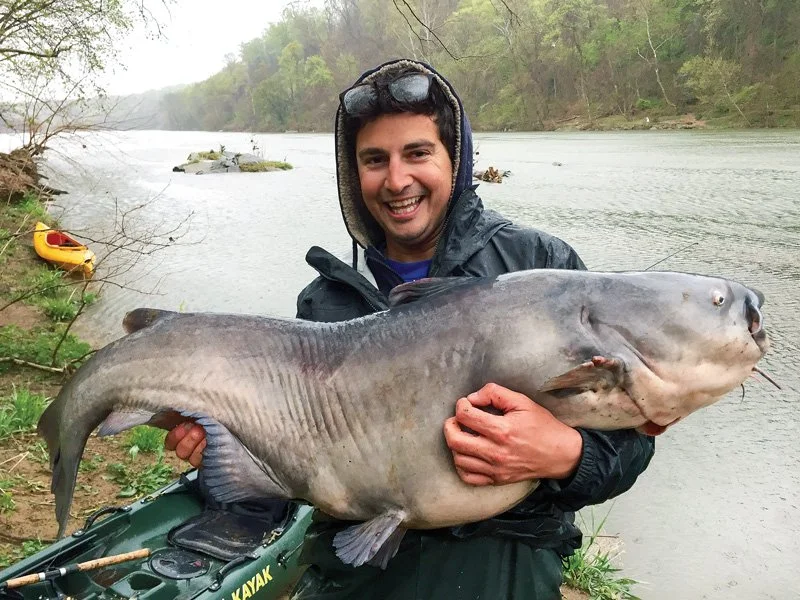The best way to beat back the exploding population of invasive blue catfish in Chesapeake Bay is to eat them.
by Charlie Levine, Anglers Journal Magazine - July 7, 2025
The Uber driver’s face was puckered with confusion. “Here?” he asked as I was about to get out of the car at the end of a road with nothing but beach in front of me. “Yup, here,” I said. “I’m going fishing.”
The drop-off/pickup spot was Sandy Point State Park outside Annapolis, Maryland, just north of the Chesapeake Bay Bridge. I walked down a dirt path and spotted the gray hull of Jay Fleming’s classic 22-foot Privateer nose-in on the beach. Fleming, 37, is a talented, well-known photographer who has spent his life on these waters, fishing, boating and documenting the people who make a living from the bay. Last year, Fleming brought my attention to the devastating effects of the invasive blue catfish with a social media post. He explained that Maryland had created a $15 trotline license for anyone wanting to commercially catch catfish, with no limits on size or harvest. The hope is that more anglers will run lines and take a notch out of the exploding catfish population.
Chefs and fishermen are working together to curb the population of blue catfish.
Fleming tossed me a pair of knee-high deck boots for the few steps I had to take through the water to reach his boat. The gale-force wind nearly blew my hat off. I was surprised he was out fishing in these conditions. “The lines aren’t far away,” he told me, handing me bright-orange PVC bibs and a jacket
The Virginia Department of Wildlife Resources introduced blue cats into the James River in the 1970s as a recreational gamefish. “At that time, striped bass stocks were declining,” Fleming says. “It was right before the rockfish [striped bass] moratorium. People wanted something to catch. The agencies that introduced these fish didn’t think of the ecological consequences.”
In the 50-odd years since their introduction, blue cat populations have blown up. According to recent fish surveys, blue catfish make up 75 percent of the total fish biomass in portions of the James and Rappahannock rivers — three out of every four pounds of fish surveyed were blue cats. And they’re spreading. Native to the Mississippi River Basin, blue catfish adapt quickly. They’ve expanded their range from the Chesapeake’s freshwater tributaries into brackish waters, eating everything in their path, including crabs, eels, striped bass fry, fish eggs, clams, white perch and more. Catfish are also threatening some of the most important spawning areas for striped bass on the East Coast.
Virginia introduced blue catfish to the James River in the 1970s and the species is now found throughout Chesapeake Bay.
Working the Water
A large tote in the bow is full of gallon-sized plastic oyster buckets filled with gizzard shad chunks, the primary catfish bait because their tough skin helps the bait stay on the hooks. Round orange baskets are loaded with crab rope for the trotlines. The rims of five-gallon buckets are lined with 12/0 circle hooks that Fleming offset with a vice and a piece of pipe. The hooks are attached to longline clips with a 2-foot section of 300-pound mono.
Fleming is a bit of a picker. He bought the hooks, clips and rope second-hand from a waterman nicknamed Corn Flour. He found the yellow floats he uses to mark the lines on a trip to Maine, and the weights on the ends of the trotlines are a mix of savaged window sashes, chain and brake rotors.
Photographer Jay Fleming grew up fishing in the bay and is doing his part to combat the blue catfish invasion by spreading awareness and working with chefs.
The wind kicks spray in our faces as we move toward the first line. The water temperature is around 50 degrees. Jack Torney, a 22-year-old crabber who keeps his boat near Fleming’s house, starts retrieving the line hand-over-hand. He unlatches the longline clips and tosses them in a cooler. I remove the shad, place the hooks on the rim of the bucket and drop the clips in. Flemimg and Torney had caught only one cat before picking me up, which Fleming surmises may be due to the full moon, a rise in salinity from drought conditions or perhaps the effects of the open season on these ugly kitties.
“We got one on here, Cap,” Torney says as he slings a bait at me. The dark back of a chunky catfish rolls in the current. Fleming sinks a gaff in its head and hauls the lumbering fish over the gunwale and into a garbage can. It’s a solid 20-pounder. I slap the fish’s side; it sounds like a water balloon. We pull in four more fish on the first line, the largest weighing about 35 pounds. It’s oddly fun and rewarding to harvest these wide-mouthed catfish. I’m covered in shad scales and catfish slime in no time. I feel like Mike Rowe on an episode of Dirty Jobs.
The stomach contents of a blue catfish show that these indiscriminate eaters have an appetite for crabs, shellfish and juvenile fish.
The second line produces a few fat cats, as does the third, but we only score three fish on our fourth and final line before we rebait, reset and head for the barn. We finish the day with about 200 pounds of fish. “I’d rather not catch them than have them in abundance,” Fleming says, “but it does provide commercial fishermen with a fishery that has no regulation and is seemingly sustainable when other fisheries are in decline.”
Fleming is friends with many crabbers and pound-net fishermen. He admires their work ethic and ability to make a living on the water. It’s evident in his photos and the friendships he’s made throughout the region.
Catfish On the Potomac
The next day, we trailer Fleming’s smaller boat, an 18-foot Privateer that’s a clone of his larger center console, to the Potomac River in Washington D.C. We launch at the foothold of Ronald Reagan Airport as an Alaska Airlines flight screams overhead. We slowly motor upriver, past shad fishermen casting from the banks and several boats anchored up, including a catfishing charter boat with a dozen lines sticking off the stern like a porcupine.
Fleming caught his largest blue catfish, a 63-pounder, from a kayak on the Potomac River.
This time, we are armed with spinning rods, egg sinkers, soft plastics and more gizzard shad. The salinity here is zero. “This is where the catfish thrive, but they’ve adapted to be able to live out in the middle of Chesapeake Bay where the salinity is 10 to 12 parts per thousand,” Fleming says.
Fleming points to a rock and says he caught his largest catfish there, a 63-pound blue — from a kayak. It seems like a good place to start. We fish knocker rigs with chunk bait, and Fleming hooks up almost immediately, a fish that’s just a couple of pounds. After a few more fish, Fleming hollers, “That was a big hit. This is a nice fish!”
A huge flathead catfish, also invasive, appears next to the boat. It looks prehistoric, with a head the size of a hubcap. We land a handful of fish, but nothing close to the trotline action. At about noon, we call it a day and give our remaining bait to a family fishing from a pontoon boat.
A Versatile Protein
That evening, Fleming and his girlfriend, Shelby Collinson, invite me to dinner at Leo Annapolis. Fleming and executive chef Matt Lego have become friends and are cut from the same cloth when it comes to irradicating catfish via the mouths of hungry patrons. A Maryland native, Lego is creating recipes that transform these invasive fish into refined table fare.
Chef Matt Lego is one of several chefs creating refined catfish dishes to help drive demand and create a market for local watermen.
We start with catfish croquetas, which are beautifully crunchy on the outside and smooth and delectable on the inside. You wouldn’t know they’re filled with catfish. We crush a plate of crispy catfish nuggets, and I choose the pan-seared catfish fillet with mushroom risotto for my entrée. It’s all phenomenal. I’d always thought of catfish as a muddy-tasting fish, but that’s not the case with these fresh-caught fillets.
Lego joins us on Fleming’s boat the next morning, and he and I pull trotlines together alongside a crew from a public television show called Maryland Farm & Harvest.Fleming invited the producers on board to expand awareness of the situation and show how local chefs are getting involved.
When I ask Lego how he became interested in offering catfish at his restaurant, he says it started with northern snakehead, another invasive species affecting the watershed. By serving these fish in an elevated manner, guests begin to see them as a fine-dining option. This helps create more demand and higher prices for commercial fishermen and fish houses while chipping away at the population. It’s a win-win all around. More chefs are coming on board all the time. The Annapolis Maritime Museum hosted a Catfish Cookoff in late spring with premiere chefs from the area serving up blue catfish in a slew of inventive dishes.
“I see blue catfish as a threat to everything I grew up with on the Chesapeake Bay,” Fleming says. “I’m afraid the next generation of anglers is not going to be able to experience what I had. We were catching striped bass, flounder, seatrout and bluefish in the upper bay. Now rockfish are thinning out. White perch are thinning out. Blue catfish clearly aren’t going away, but they’re relatively easy to catch, they get big, and they taste decent. It’s a great way to get kids involved in fishing and educate them about invasive species and conservation.”
Lego pulls several fish over the gunwale, and I can see the hook-to-table concept playing out in front of me. “The only way to beat ’em is to eat ’em,” he says.






